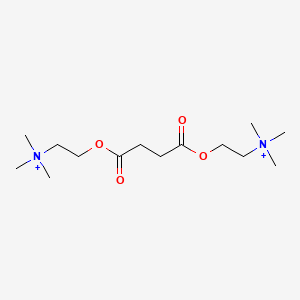Attribution Statement: LactMed is a registered trademark of the U.S. Department of Health and Human Services.
NCBI Bookshelf. A service of the National Library of Medicine, National Institutes of Health.
Drugs and Lactation Database (LactMed®) [Internet]. Bethesda (MD): National Institute of Child Health and Human Development; 2006-.
CASRN: 306-40-1

Drug Levels and Effects
Summary of Use during Lactation
No information is available on the use of succinylcholine during breastfeeding. Because it is rapidly eliminated and poorly absorbed orally, it is not likely to reach the bloodstream of the infant or cause any adverse effects in breastfed infants.[1,2] A general anesthetic regimen that included succinylcholine for cesarean section caused a delay in the time to the first breastfeeding, but the part that succinylcholine played in this difference in outcome in unknown.
Drug Levels
Succinylcholine is rapidly hydrolyzed in maternal plasma and has a short half-life of about 3 to 5 minutes. It is unlikely to be excreted into milk or absorbed orally by the infant because of its highly polar nature.[1]
Maternal Levels. Relevant published information was not found as of the revision date.
Infant Levels. Relevant published information was not found as of the revision date.
Effects in Breastfed Infants
Relevant published information was not found as of the revision date.
Effects on Lactation and Breastmilk
A randomized, but nonblinded, study in women undergoing cesarean section compared epidural anesthesia with bupivacaine to general anesthesia with intravenous thiopental 4 mg/kg and succinylcholine 1.5 mg/kg for induction followed by nitrous oxide and isoflurane. The time to the first breastfeed was significantly shorter (107 vs 228 minutes) with the epidural anesthesia than with general anesthesia. This difference was probably caused by the anesthesia's effects on the infant, because the Apgar and neurologic and adaptive scores were significantly lower in the general anesthesia group of infants. It is not known what part succinylcholine played in this difference in outcome.[3]
Alternate Drugs to Consider
References
- 1.
- Spigset O. Anaesthetic agents and excretion in breast milk. Acta Anaesthesiol Scand. 1994;38:94–103. [PubMed: 8171959]
- 2.
- Howie WO, McMullen PC. Breastfeeding problems following anesthetic administration. J Perinat Educ. 2006;15:50–7. [PMC free article: PMC1595306] [PubMed: 17541461]
- 3.
- Sener EB, Guldogus N, Karakaya D, et al. Comparison of neonatal effects of epidural and general anesthesia for Cesarean section. Gynecol Obstet Invest. 2003;55:41–5. [PubMed: 12624551]
Substance Identification
Substance Name
Succinylcholine
CAS Registry Number
306-40-1
Drug Class
Breast Feeding
Lactation
Muscle Relaxants
Neuromuscular Depolarizing Agents
Disclaimer: Information presented in this database is not meant as a substitute for professional judgment. You should consult your healthcare provider for breastfeeding advice related to your particular situation. The U.S. government does not warrant or assume any liability or responsibility for the accuracy or completeness of the information on this Site.
- User and Medical Advice Disclaimer
- Drugs and Lactation Database (LactMed) - Record Format
- LactMed - Database Creation and Peer Review Process
- Fact Sheet. Drugs and Lactation Database (LactMed)
- Drugs and Lactation Database (LactMed) - Glossary
- LactMed Selected References
- Drugs and Lactation Database (LactMed) - About Dietary Supplements
- Breastfeeding Links
- PMCPubMed Central citations
- PubChem SubstanceRelated PubChem Substances
- PubMedLinks to PubMed
- Succinylcholine - Drugs and Lactation Database (LactMed®)Succinylcholine - Drugs and Lactation Database (LactMed®)
Your browsing activity is empty.
Activity recording is turned off.
See more...
